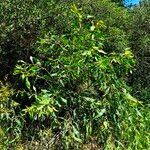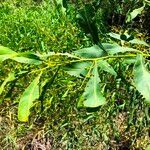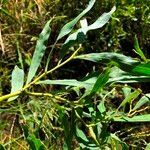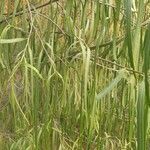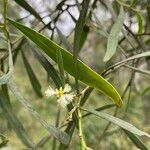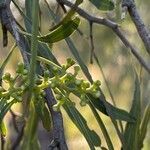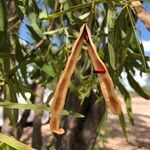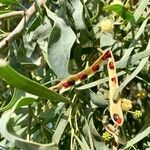Shrub or tree 3–13 m high, sometimes to 20 m high in N.S.W., often clonal due to suckering habit. Branchlets pendulous, dark grey-brown, glabrous. Phyllodes pendulous, variable, linear to narrowly oblanceolate or narrowly elliptic, 7–20 cm long, 4–30 mm wide, l: w = 4–40, ± flaccid, green to grey-green, sometimes glaucous, glabrous, 1-veined, penninerved; glands 2–5, lowermost 0–5 mm above pulvinus, and distal glands often prominent and one at base of mucro. Inflorescences 2–8-headed racemes; raceme axes 1–5 cm long, glabrous, rarely appressed-puberulous; peduncles 5–15 mm long, glabrous; heads globular, subdense, 15–25-flowered, cream to pale yellow. Flowers 5-merous; sepals united into a ±truncate calyx. Pods narrowly oblong, to 12 cm long, 7–13 mm wide, woody, thick, longitudinally striate when dry, grey-green, glabrous. Seeds longitudinal, elliptic to oblong-elliptic, 4.5–6 mm long, shiny, dark brown to black; aril scarlet.
More
An evergreen shrub or tree. It grows to 4-12 m tall and with a spread of 3-5 m. The stem is erect and has suckers. The tree has a rounded crown. The branches hang downwards almost reaching the ground. This gives the tree a willow like appearance. The leaves (phyllodes) are long, green and narrow. They have a single vein. They can be 5-20 cm long and 0.5-1 cm wide. They are thick. The flower heads are pale yellow balls. They occur in small sprays of 2-5 balls. The pods are brown. They are 2-7 cm long by 0.6 cm wide and straight. They are constricted between the seeds. They are thick and woody.
It grows in Mediterranean climate places. It occurs naturally in mainland Australia. It can grow on many soils but prefers heavy clays. It requires an open sunny position. It is drought and frost resistant. They are mostly found along streams. They are very hardy. It can grow in semi arid places but benefits from water during the dry season. It normally occurs south of 20°S latitude. It probably does best where summers are hot and rainfall is 35-55 mm. It can grow in arid places. It suits hardiness zones 8-9.
More
Grows mostly along water courses and on floodplains, in soils ranging from sand to clay. For full discussion of habitat and of uses, see J.W. Turnbull (ed.), Multipurpose Australian Trees and Shrubs 192 (1986).
Woodland and open-woodland, mostly along water courses and on floodplains, in soils ranging from sands to heavy clays; at elevations up to 2,000 metres.
Woodland and open-woodland, mostly along water courses and on floodplains, in soils ranging from sands to heavy clays; at elevations up to 2,000 metres.
Details of utilisation of Acacia salicina are given in J.W. Turnbull (ed.), Multipurpose Australian Trees and Shrubs 192–193 (1986), J.C. Doran et al., in J.C. Doran & J.W. Turnbull (eds), Australian Trees and Shrubs: Species for Land Rehabilitation and Farm Planting in the Tropics 208–209 (1997), G. Lithgow, 60 Wattles of the Chinchilla and Murilla Shires 50 (1997) and D.J. Boland et al., Forest Trees of Australia 5th edn, 178–179 (2006).
More
The seed are eaten. They are ground into flour and made into bread.
It is grown from seed. The seed need treatment to break the hard seed coat. Normally this is by putting the seeds in very hot water and letting the water cool down overnight then planting the seeds immediately. The plants spread by suckers. Because of the range of climates where it will grow, it is best to collect seeds from within the area where it is to be produced.
